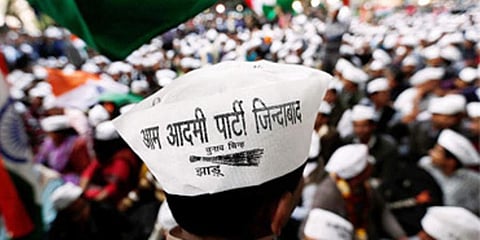

NEW DELHI: Disenchantment against established political parties, coupled with populist measures and leadership clarity, was among the primary reasons for the AAP's thumping poll victory in Punjab, but the party did not get the same traction in Uttarakhand and Uttar Pradesh as the discontent was not high against the existing parties there, political analysts observed.
The AAP swept the Punjab assembly polls, results of which were announced on Thursday, bagging 92 seats in the 117-seat assembly.
Several top leaders from the ruling Congress and opposition Shiromani Akali were trounced.
Chief minister Charanjit Singh Channi, former chief ministers Parkash Singh Badal and Amarinder Singh, SAD leaders Sukhbir Singh Badal and Bikram Singh Majithia and Punjab Congress chief Navjot Singh Sidhu lost the polls.
The AAP bagged 42 per cent of the total votes polled, while the first runner-up Congress and second runner-up SAD were way behind the AAP securing 23 and 18 per cent votes respectively.
However, the AAP could not replicate its success of Punjab and Delhi in other states.
In Uttarakhand, it drew a blank and won two seats in Goa.
The BJP posted a handsome victory in Uttar Pradesh and Uttarakhand, secured a simple majority in Manipur and was the largest party in Goa.
Sanjay Kumar of the Centre for Study of Developing Societies, Delhi, said it is the combination of several factors that contributed to the AAP's stupendous performance.
He said the percentage of votes bagged by the AAP in Punjab shows that there was massive disenchantment against the ruling Congress and the SAD.
But factors such as populist measures and leadership were also major determinants that led to the AAP's victory in Punjab, Kumar noted.
The AAP has promised 300 units of free electricity, education and health reforms on the lines of Delhi.
On the leadership front, the party projected AAP national convener and Delhi chief minister Arvind Kejriwal as the party leader and Bhagwant Mann as its chief ministerial candidate for Punjab.
This is not for the first time that the AAP tried to sell the Delhi model of governance.
In 2017, it tried hard to sell the model in Punjab but could only bag 20 seats.
It contested Goa and Gujarat assembly polls in 2017, Maharashtra and Haryana assembly polls in 2019 but failed to win even one seat.
Political scientist Suhas Palshikar said leadership or populist measures were not the primary factors behind the AAP's victory in Punjab.
"Disenchantment against the existing ruling parties was the major reason behind AAP's feat," he said.
Palshikar pointed out that 2022 was the AAP's second attempt to secure power in Punjab.
For the first time, AAP's four MPs got elected to Lok Sabha in 2014 from Punjab, not Delhi.
In 2017, the AAP secured 20 seats and 23 per cent votes, bagging the honour of becoming an opposition party in its very first attempt.
So the party was not starting from scratch in Punjab, said Palshikar, who is a former professor of political science at the Savitribai Phule University, Pune.
He noted that Delhi has a large section of people who have connection with Punjab.
A lot of Sikh population from Delhi also hails from Punjab, so there is a natural connect in what happens in Delhi and Punjab, Palshikar added.
The AAP secured a second term in Delhi, bagging more than two-thirds seats in the national capital in 2020.
However, the AAP could not tap on to the anti-incumbency in Goa, Uttarakhand and Uttar Pradesh.
Perhaps, the levels of discontent in Goa, Uttarakhand and Uttar Pradesh were not as high as Punjab, Palshikar observed.
Plus, the AAP had not contested in other states with the party using its full strength in Punjab, he added.
Uttara Sahashrabuddhe, a political science professor at the Mumbai University, echoes Palshikar.
"The kind of disillusionment against the established parties which was seen in Punjab was not seen in Goa," Sahashrabuddhe said.
She said there were other factors behind AAP's performance in Delhi and the leadership crisis in the opposition parties was definitely a major one.
"The way Amarinder Singh was sacked as the chief minister and internal squabbles too contributed to the Congress defeat," she said.
On the other hand, the AAP looked united.
Researcher, political analyst and journalist Sandesh Prabhudesai said the AAP may have won power in Punjab, but it failed to understand the electorate in Goa.
"It tried to flaunt (in Goa) the Delhi model of education, but then the literacy in Goa is high. Dayanand Bandodkar, the first chief minister of Goa, ensured that schools were there in every village. The healthcare system in Goa is much better than other parts of the country," he said.
"More importantly, the AAP failed to understand Goan politics," he said, noting that it declared Amit Palekar, belonging to the state's dominant Bhandari caste, as its chief ministerial candidate.
"Goa has never voted on the lines or caste or religion," Prabhudesai added.
As AAP now focuses to be a national party, the next state on its list is Gujarat and Himachal Pradesh, a senior AAP leader added.
"People in these states need an alternative and AAP is the one," the leader added.